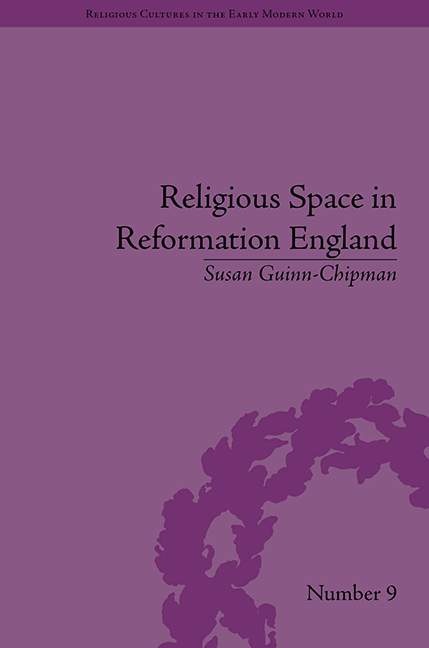Book contents
- Frontmatter
- CONTENTS
- Acknowledgements
- List of Figures
- Introduction
- 1 Dissolution and Adaptation: Religious Space in Henrician England
- 2 Radicalization and Response: Religious Space in Late Henrician and Edwardian England
- 3 Reframing the Parish Church in Marian and Elizabethan England: Cultural Adaptation in the Later Sixteenth Century
- 4 Contesting Religious Space: Alteration and Reaction in Stuart England
- Epilogue: The Persistence of Memory in Early Modern England: Mapping the Past
- Notes
- Works Cited
- Index
3 - Reframing the Parish Church in Marian and Elizabethan England: Cultural Adaptation in the Later Sixteenth Century
- Frontmatter
- CONTENTS
- Acknowledgements
- List of Figures
- Introduction
- 1 Dissolution and Adaptation: Religious Space in Henrician England
- 2 Radicalization and Response: Religious Space in Late Henrician and Edwardian England
- 3 Reframing the Parish Church in Marian and Elizabethan England: Cultural Adaptation in the Later Sixteenth Century
- 4 Contesting Religious Space: Alteration and Reaction in Stuart England
- Epilogue: The Persistence of Memory in Early Modern England: Mapping the Past
- Notes
- Works Cited
- Index
Summary
Writing Easter week of 1558, churchwardens Robert Bishop and Robert Lambert of St Michael the Archangel at Mere recorded ‘varyannce and Contencon’ among certain of the parishioners. Amid the rising tensions of the following autumn, with the death of ‘or sayd sou'aigne lady Quene Marye (who dyed the xvijth day of Nouembre in the sayd yere of or lorde 1558’ and the resulting ‘Alteracon of some p[ar]te of Relygyon’ as her sister Elizabeth took the throne, alterations in the parish church ceased. Bishop and Lambert had only recently seen to the restoration of the image of Saint Michael and to the amending of the rood loft during the preceding year. That contention arose among parishioners was hardly surprising. In little more than two decades, divergent Tudor alterations had generated sweeping changes to the English religious landscape. Upon Mary I's accession on 19 July 1553, the Catholic Queen initiated a restoration of recently suppressed images, altars and intercessory institutions. Her early death and the accession of Elizabeth I just five years later brought an end to the Marian effort and signaled an Elizabethan revival of Protestant church interiors along Edwardian lines. The ‘varyannce and Contencon’ at Mere reflected an increasingly divided English community, with parishioners and clergy compelled to once again implement Crown alterations and to re-engage with questions over the orthodoxy of their own parish church interior and their places within it.
- Type
- Chapter
- Information
- Religious Space in Reformation EnglandContesting the Past, pp. 73 - 94Publisher: Pickering & ChattoFirst published in: 2014



